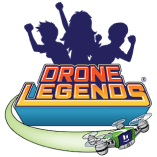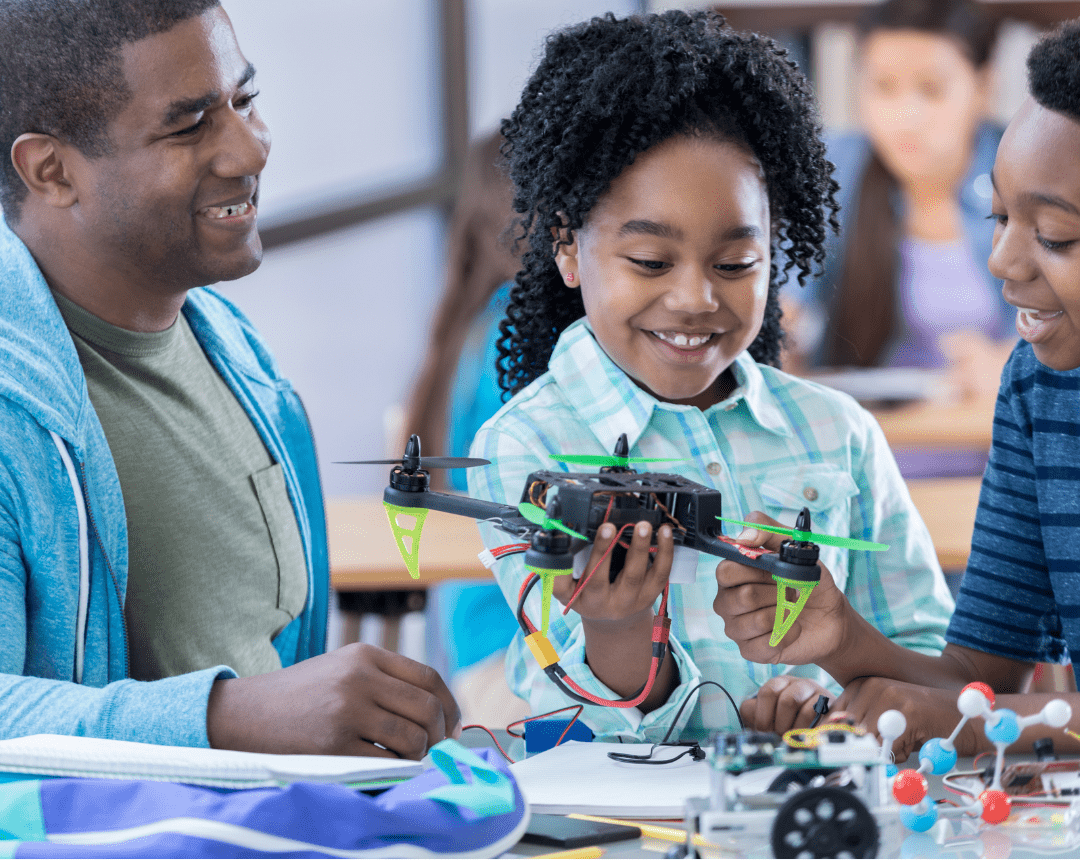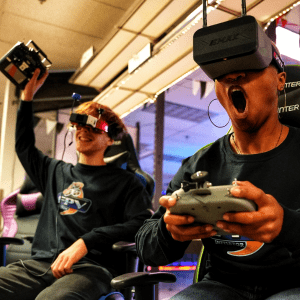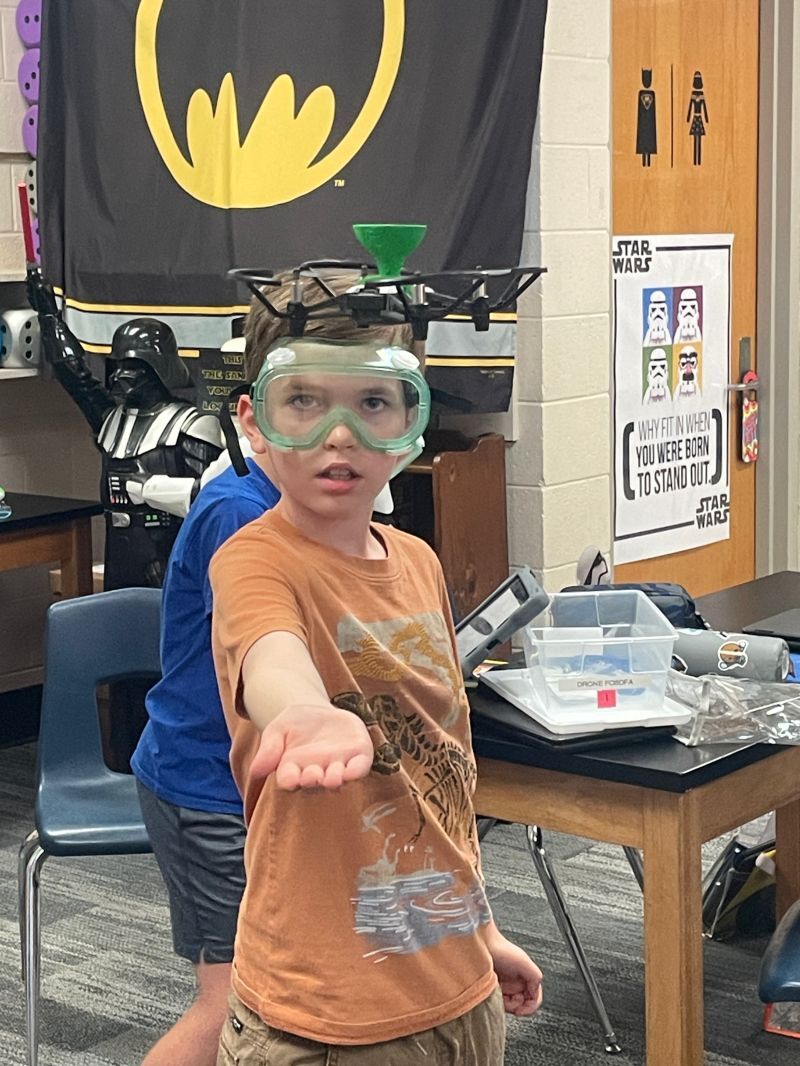The Drone Legends team recently interviewed Mark Kaercher, a math teacher of over 25 years who now runs a sixth grade Innovation Lab. We discussed what it’s like to run his learning/simulation center and how Mark connected with Drone Legends. We asked Mark how the Drone Legends curriculum has impacted his students and why he loves using drones in the classroom. Here’s what Mark shared.
How did you become involved with Drone Legends?
I run what’s called a simulations center, which is one of six innovation places we have in our middle school. All of our sixth grade students go through each of the six innovation spaces. I taught math for 27 years before taking on this role, so when my superintendent presented the idea to me, I started researching simulation spaces. Using drones made sense because they’re being used in more and more industries.
I became connected with Scott and learned about Drone Legends through Twitter interactions. As I learned more about what you can do with drones, I loved that Scott put emphasis on the application of drones. He’s got these wonderful missions that Drone Legends has put together for the kids to work through. I pitched the idea to my superintendent and asked if we could bring this in- he said absolutely. At the time, I was planning a drone camp for the summer, and I wanted it to be a Drone Legends camp. I’ve got Drone Legends in my back pocket now, and I’m so glad that I do.
What is it like to run the Innovation Labs?
All the sixth graders make their way through each of the labs. I run the Simulation Center, but we also have a Maker Space, Coding and Robotics Lab, Clean Tech Lab, Humanities Center, and a Health, Wellness, and Mindfulness Center.
Right now, we have kids in each of those spaces for 5 weeks. After 5 weeks, they rotate to the next space. When schools received funding during COVID- some districts built a football stadium, but our district invested in these innovation spaces. It coincided with a major renovation of our middle school and the timing was great.
What does the day-to-day running of the program look like?
I start off with a 2-week drone unit and the first week is about the mechanics of drones. You start off on the simulator, then we put the drones in their hands, and they do simple missions and test flights. They might learn:
- How to take off and land
- How to do a flip
- How to throttle up and down
Then we work our way into the Drone Legends missions. By this point, I already have the teams and roles assigned. I put together a box with each team’s clipboard, tape measure, drones, and batteries, and the lead person of each team gets their box. Once everyone has their materials, we start the debriefing and talk about today’s mission. We use a more remote location down the hall from my classroom where there are no other classes going on that we might interrupt. The students run their mission, and I go back and forth between the teams and oversee the missions. It’s chaotic, but it’s good chaos.
What do you see happen in kids from week one to the last mission?
There’s an incredible amount of growth. I’m always amazed when we do this. I was a high school teacher for a long time, and now I’m a sixth-grade teacher. Seeing what these sixth graders will do- from being able to connect their Chromebook to the drone, and if the drone’s not taking off, they try to figure out what’s going on. So they’re checking the batteries and replacing propellers. There’s a lot. And that’s why the setup that Scott has for the roles on each team makes the program work really smoothly. I’m so blown away by the skills that these kids develop by engaging with this program.
When you bring drones in the classroom, students are developing skills they might need in the future. Why does this matter?
That’s one of the great things about drones, and I think the Drone Legends program has really opened my eyes to what kids can do with drones. I knew a little bit about what drones can do, but there are really incredible applications. Being able to introduce those skills to these kids at this age, I’m hoping, opens their eyes to the possibilities. After the first two weeks, many kids say, “I’m going to ask my parents to buy me a drone!” Some even say, “My parents are in real estate, and they use drones to take pictures of the houses they put on the market.” It’s super important to give these kids some really practical and valuable technical skills that I’m hoping they can carry forward.
Scott’s vision for Drone Legends was to create an academically rigorous STEM program that included social-emotional learning. Have you seen that come to life in your practice of the program?
Very much. Especially in the drone camp I did this past summer. We had a mix of sixth, seventh, and eighth graders. We had about 22 kids in each camp. There were kids from all different racial backgrounds, socio-economic backgrounds, and grade levels. To see these kids come together and work together- it was a magical thing to watch. A lot of the time, when I have my students working with drones in the hallway, other teachers will stop and watch. I think the social-emotional piece is a powerful part of the Drone Legends program. The Drone Legends program really makes it organic by assigning roles and getting the kids to work together. It’s a home run.
Let’s say another educator who had never flown a drone before asked you if it was possible for them to use drones in the classroom- what would you tell them?
Yes. Period. Hard stop. I had zero drone experience when I got involved with this. Some people are very tech-phobic. There’s always going to be those teachers. But if teachers have any interest, the training is available. The resources are available. If this is something you’re interested in, just start by playing. Bring a drone home and instead of watching Netflix one night, fly the drone instead. You might find yourself having just as much fun as the kids.
What else would you share with teachers on why programs like this are important? Why does it matter that kids have these kinds of experiences?
As a former math teacher, I’m going to integrate a lot of mathematics in my teaching. But when you look at the Drone Legends missions, they’re incorporating ELA skills with the reflection pieces, or they’re incorporating global studies with the videos and discussions of things across the globe. Students may not get those cross-curricular activities elsewhere, so it’s important for someone like me to provide those opportunities.
Drone Legends in Innovation Labs
At Drone Legends, we know teachers are the real heroes. When educators like Mark Kaercher find creative ways to use drones to the classroom, students share valuable experiences that prepare them for the future.
Innovation Labs are just one way to incorporate drones in the classroom. The Drone Legends curriculum makes it easy for any educator or volunteer to implement a drone program in their school or club. Drones are fun, educational, and a great way to build character.
Check out our curriculum today to see how it could impact your school!




